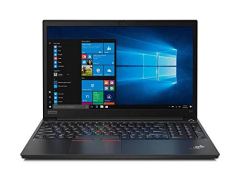
A powerful, portable, well-rounded model.
A powerful, portable, well-rounded model.
Contains a fast Intel Core i7 processor. Clear 13.5-inch 2256 x 1504 display. Very thin and lightweight. Fast DDR4 RAM. Packs 1TB SSD for storage. Great features and will work great as a PC.
Speakers are underwhelming. Not a great pick for gaming.

Well worth the purchase for anyone who needs a conveniently designed combination laptop and tablet.
Well worth the purchase for anyone who needs a conveniently designed combination laptop and tablet.
Especially fast WiFi connectivity. Flexible hinge for tablet mode. Up to 10 hours of battery life. Sharp 13.3” Full HD display. Powerful stereo speakers. A wide array of ports. The included touchscreen is very responsive. Runs most programs very quickly.
Its camera is not particularly impressive.

With its fast processor, crisp touchscreen, and versatile array of ports, this option can handle anything you can throw at it.
With its fast processor, crisp touchscreen, and versatile array of ports, this option can handle anything you can throw at it.
Includes a 10th generation quad-core Intel i5 processor. The 13.3-inch IPS display works as standard or touchscreen. Choose from five sizes of SSD, ranging from 128GB to 2TB. Contains 1 Thunderbolt 4 port, 1 USB-C port, and a microSD card reader.
Battery life could be improved. Not ideal for gaming due to integrated graphics.

A sturdy business model that easily switches operating systems.
A sturdy business model that easily switches operating systems.
The Intel i5 processor is fast and capable. Large 15.6-inch screen is perfect for business or media streaming with 16GB of DDR4 RAM and a 512GB SSD. A solid pick for multitasking. Ports include 1 USB-C, 2 USB 3.1, and 1 HDMI.
Battery life is average.

The Chromebook Flip C436 is one of the most flexible models available.
The Chromebook Flip C436 is one of the most flexible models available.
The 360-degree hinge lets you adjust to any angle you want. Solid Intel i3 CPU. Offers WiFi 6 support. The super-thin bezels maximize the screen real estate. It has plenty of ports for peripherals, too.
Power users may prefer a Chromebook with a more powerful processor.

We recommend these products based on an intensive research process that's designed to cut through the noise and find the top products in this space. Guided by experts, we spend hours looking into the factors that matter, to bring you these selections.

Updated July 2022
While most computer users are familiar with mainstream operating systems like Windows, MacOS, or Chrome OS, there’s another option: Linux. Linux is an open-source operating system, meaning it’s free, and anyone can modify it and create different versions. In fact, there are hundreds of different kinds of Linux, ranging from sparse developer-friendly versions to consumer-friendly versions that look and feel like other mainstream operating systems.
Because Linux isn’t owned by anyone, it’s up to hardware manufacturers to make it available on their computers or provide tools to help users do it themselves. Most major computer makers offer at least a few Linux-friendly laptops and, in some cases, users take it upon themselves to write drivers and software themselves. If you’re new to Linux, it’s best to find a laptop with it preinstalled, but if you’re a veteran user, you can look for a compatible laptop and install Linux on your own.
If you’re ready to join the thousands of users around the world enjoying the simplicity and stability of Linux, you’re in luck — there are plenty of great, affordable options that make Linux easy to learn and use.

When it comes to laptops, it’s easy to overspend. Keep costs down by considering these three questions before you shop:
Which version of Linux do you plan on using? This is the most important decision to make ahead of time so you know what you’re getting. For example, most first-timers opt for Mint Linux or Ubuntu Linux, because they’re so user friendly for Linux newbies. Once you know which version of Linux you’ll be using, you can then limit your search to only include models that support your version of choice.
Do you need a laptop with a touchscreen? More and more laptops are shipping with touchscreen displays, so you can use them both as a laptop and a tablet. These laptops, dubbed “2-in-1s,” are great if you need a machine that’s flexible enough to do both. But as you might expect, touchscreens drive up costs overall. The bottom line: if you’re looking for a laptop/tablet hybrid, pick up a 2-in-1 and get the best of both worlds.




















Here are the tech specs to compare as you’re looking at different Linux laptops:
Driver support. The single most important factor when it comes to Linux on laptops is driver support. Drivers are, essentially, the instructions that allow an operating system to interact with and control hardware components. Practically every aspect of a laptop’s hardware has drivers, from the display to the keyboard to the USB inputs. If you’re buying a laptop with Linux preinstalled, you can be certain the manufacturer has provided drivers. If you’re planning on installing Linux to a laptop that initially comes with a different operating system, research ahead of time to make sure the version of Linux you’re installing has all of the necessary drivers for the laptop hardware before you begin the process. (If you try and install Linux without full driver support, you won’t be able to use critical hardware features.)
CPU. A laptop’s central processing unit, better known as the CPU, is the heart of your computer. Everything flows through it — and faster CPUs can process more information, so your computer can run faster. Faster CPUs are more expensive, so keep in mind that less expensive Linux laptops run slower than more expensive ones.
RAM. Random access memory (RAM) is the memory computers use to handle multiple tasks at once. Not enough RAM can make any laptop slow, so it’s important to get a Linux laptop with 4GB of RAM at a bare minimum.
Inexpensive: In the $200 to $350 range, you’ll find plenty of Linux laptops geared toward casual users. Models in this price range are usually underwhelming hardware-wise; they typically rely on slower processors and include only the bare minimum of RAM. That said, Linux is built for running on minimal hardware, so entry-level users can have good experiences on laptops from this price range.
Mid-range: Between $500 and $700 is where it starts to get interesting. In this price range, you’ll find laptops that hit the sweet spot of power and affordability — so it’s not hard to find models with fast CPUs, plenty of RAM, and forward-looking tech like USB-C ports, Bluetooth, and 802.11ac WiFi.
Expensive: In the $800 to $1,200 price range, you’ll find the most powerful Linux laptops out there. Expect to pay this much if you’ve got high end or specific needs — for example, if you’re going to use a Linux laptop for your daily job or for gaming, you’ll need to spend this much to get one that’s got the appropriate hardware inside.
Only buy from manufacturers you know. There are a lot of no-name computers out there that run Linux, but we recommend avoiding them. Linux is community-supported, and that means that if you ever need help, you’ll need to reach out to others who own the same hardware as you — which can be really difficult if your laptop is made by a smaller, no-name manufacturer. Stick to brands like Lenovo, HP, Dell, ASUS, System76, Acer, Microsoft, Toshiba, Star Labs, or Samsung.
Make sure your accessories like your printer are all Linux-compatible. When it comes to getting all your hardware to work correctly with Linux, don’t forget about your peripherals. Consider all of the hardware that your computer connects to, from your printer to external hard drives, and triple-check to make sure all of them are Linux-friendly. If you have any accessories that aren’t compatible, consider getting a laptop with a different version of Linux or buying new accessories.

Q. Can I install Linux on an Apple laptop?
A. You can, but we wouldn’t recommend it. While some users have had limited success getting Linux to run on Apple hardware, driver support and stability are anything but reliable. If you’ve got an Apple computer and you want to try out Linux, consider creating a virtual machine using software like VirtualBox and installing Linux there.
Q. How technical do I need to be to install Linux on a laptop?
A. Not very. Most consumer-friendly versions of Linux, such as Ubuntu Linux, are made to take the headache out of installation. If you buy a laptop and you need to install Linux on it yourself, read up on the installation process ahead of time so you know what to expect.
Q. Is Linux hard to learn as an operating system?
A. Linux is getting more user-friendly every day — and there are versions of Linux that are just as easy to use as Windows or MacOS. If you’re accustomed to mainstream operating systems, stick with mainstream versions of Linux (like Mint or Ubuntu) and the transition will be virtually seamless. Once you’ve mastered the basics, you can learn more about advanced Linux usage through things like a command line interface, where you interact with a machine by using code instead of traditional software.
Get emails you’ll love.
Learn about the products you’re wondering if you should buy and get advice on using your latest purchases.
